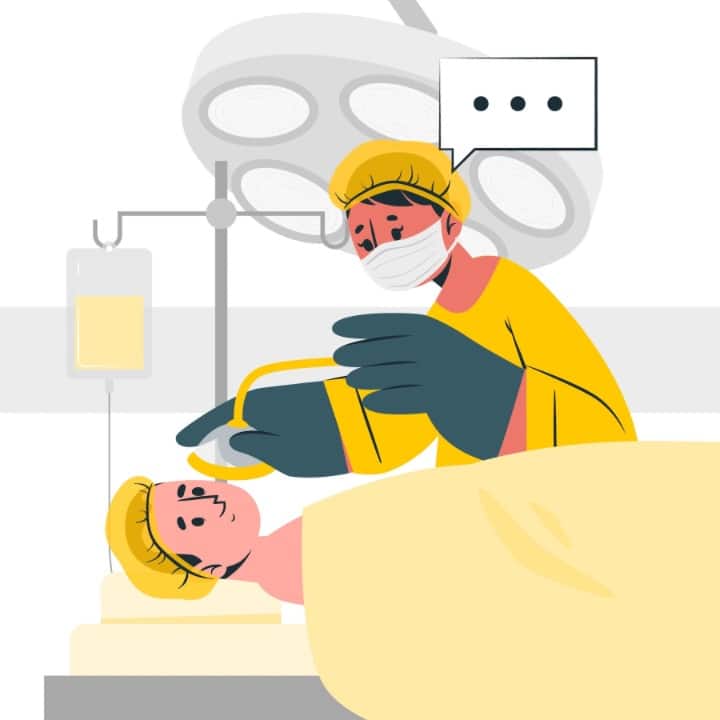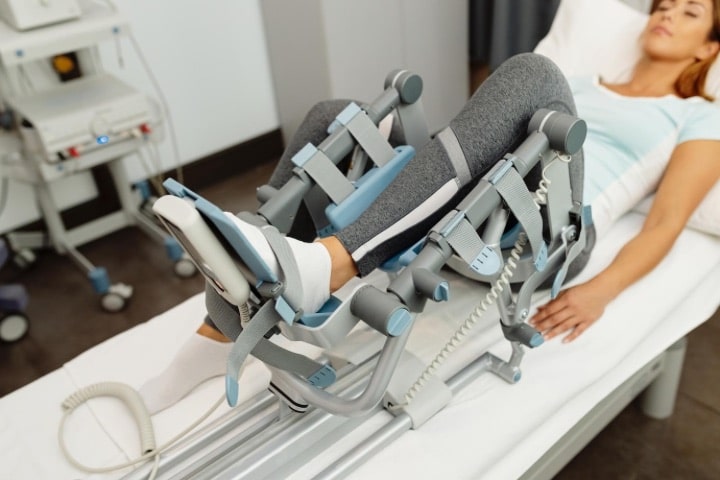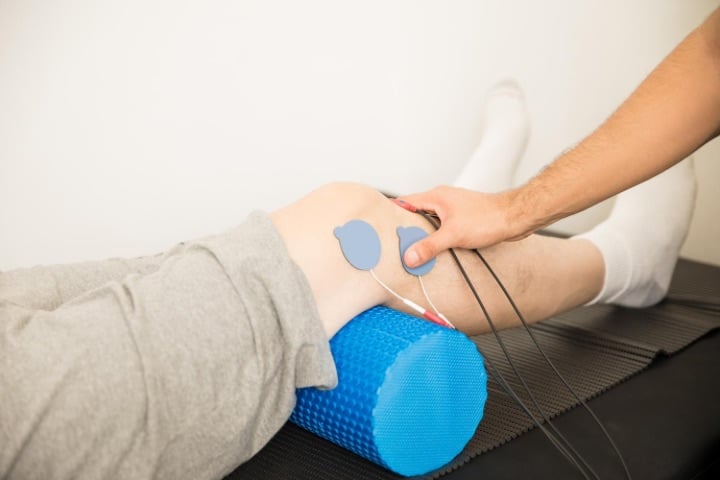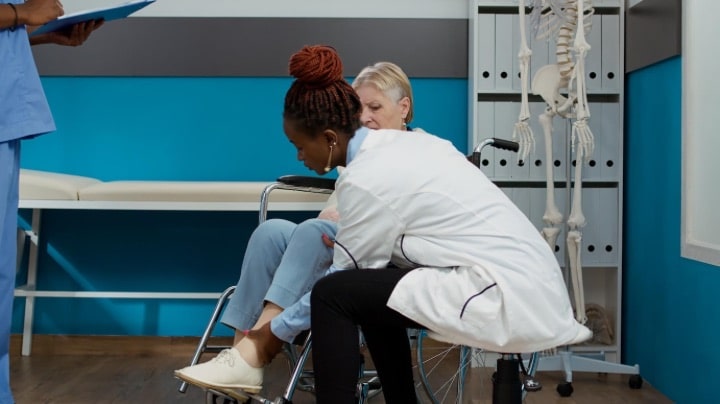There are two main options when treating knee injuries: ACL reconstruction surgery and exercise. ACL reconstruction surgery involves repairing the torn ligament in the knee through a surgical procedure, while exercise focuses on rehabilitating the knee through a specific protocol of exercises. Both ACL reconstruction and exercise have their benefits and drawbacks, and choosing between them can be difficult.
ACL reconstruction surgery is a common treatment option for individuals who have suffered a complete tear of the anterior cruciate ligament (ACL). The procedure involves replacing the damaged ligament with a graft, typically taken from the patient’s body or a donor.

Photo Credit: Storyset
ACL reconstruction surgery is typically performed under general anesthesia. The surgeon will make a small incision in the knee to access the damaged ligament. The torn ligament will be removed and replaced with a graft secured to the bone using screws or other fixation devices. The incision is then closed with stitches or staples. The entire procedure typically takes 1-2 hours.
Recovery time following ACL reconstruction surgery can vary depending on the individual, but it typically takes several months. The first few days following surgery are typically the most uncomfortable, and patients may need crutches initially. Physical therapy will be an important part of the recovery process to help restore strength and range of motion in the knee. Patients may be able to return to sports or other activities after several months of rehabilitation.
Like any surgery, ACL reconstruction comes with some potential risks and complications. These can include infection, bleeding, blood clots, and damage to surrounding nerves or blood vessels. The risk of complications can be minimised by carefully following the surgeon’s pre and post-operative instructions.
The success rate of ACL reconstruction surgery is generally high, with most patients experiencing a significant improvement in knee function. However, success rates can vary depending on a range of factors, including the injury’s severity, the patient’s age, and overall health.
ACL rehab exercises are an important part of the non-surgical treatment plan for ACL injury. These exercises involve a combination of strength, flexibility, and balance training to help patients recover from their injuries and prevent further damage. Following a specific rehab protocol is essential to ensure the best results.
Physical therapy is a critical component of non-surgical ACL treatment, as it can help patients regain their range of motion and build strength in the muscles surrounding the knee. The protocol typically involves exercises to improve balance, stability, and strength in the affected area.
Each patient’s ACL rehab protocol is customised to their unique situation. The protocol may include exercises such as squats, lunges, leg presses, and stretches to improve flexibility. Physical therapy sessions may also include resistance bands and balance boards to help with stability and balance.

Photo Credit: Drazen Zigic
While exercise can be an effective treatment option for ACL injuries, it requires strict adherence to the rehab program. Failure to follow the protocol can result in incomplete recovery and an increased risk of future injuries.
Sometimes, non-surgical treatment may be the best option for an ACL injury. This may involve a combination of rest, physical therapy, bracing, and pain management techniques. This treatment’s effectiveness depends on the injury’s severity and the level of damage to the knee joint.
Non-surgical treatment is typically recommended for less severe injuries or for patients who are not good candidates for surgery. Patients who follow a rigorous rehab protocol and implement injury prevention tips can often see positive results from non-surgical treatment.
ACL reconstruction surgery has become popular for athletes who want to return to their sport quickly. However, it is important to carefully consider the pros and cons of this treatment option before making a decision.
Ultimately, the decision to undergo ACL reconstruction surgery should be made in consultation with a medical professional and based on individual circumstances.

Photo Credit: tonodiaz
Exercise can be an effective treatment option for ACL injuries, especially for those who prefer to avoid surgery or have a less severe injury. By working with a physical therapist or sports medicine physician, patients can develop an ACL rehab exercise program tailored to their needs and goals.
One of the main benefits of exercise is that it can help improve strength, stability, and overall knee function. Patients who follow a specific rehab protocol and perform ACL rehab exercises as directed can expect improvements in their range of motion and ability to complete daily activities. Additionally, exercise can help reduce the risk of future ACL injuries by strengthening the muscles and increasing joint stability.
However, it is important to note that exercise also has limitations as a treatment option. To achieve the best possible outcome, patients must strictly adhere to the rehab program and continue with exercises even after the initial recovery period. They must also understand that exercise may not be enough to recover from a more severe ACL injury fully and may require other treatment options, such as surgery.
To increase the effectiveness of exercise as a treatment option, patients should work closely with their physician or physical therapist to develop an appropriate rehab program and follow injury prevention tips. Some examples of ACL injury prevention tips include maintaining proper form during physical activity, wearing appropriate protective gear, and avoiding high-impact activities that could strain the knee excessively.
While ACL reconstruction and exercise can be viable options for treating ACL injuries, it is important to make an informed decision that considers individual circumstances.
If the injury is severe or if the patient’s goal is to return to high-intensity sports quickly, ACL reconstruction surgery may be the best option. However, it is important to remember that surgery is invasive and has a longer recovery time.
It is also important to consider the success rate of ACL surgery. While the procedure has a high success rate overall, there may be better options for some. Before deciding, it is essential to discuss the potential risks and benefits with a medical professional.
On the other hand, exercise can be an effective non-surgical treatment option for ACL injuries. This approach can help improve strength, stability, and overall knee function. However, adherence to a strict rehab program is essential, and there is a possibility that the recovery may be incomplete.
It is important to note that non-surgical ACL treatment options are available for patients who may not be good candidates for surgery. These options can include physical therapy and other forms of rehabilitation. Working with a medical professional to determine the best course of action for each case is crucial.

Photo Credit: DCStudio
The decision between ACL reconstruction and exercise as a treatment option for ACL injuries should be made after carefully considering the injury severity, personal goals, and individual circumstances. Working closely with a medical professional to make an informed decision leading to the best possible outcome is essential.
ACL reconstruction involves surgical intervention to repair a torn ACL, while exercise focuses on rehabilitating the knee through specific exercises and non-surgical treatments.
The recovery time for ACL surgery can vary depending on individual factors, but it typically takes around 6 to 9 months to return to full activity.
Complications of ACL surgery can include infection, blood clots, stiffness, weakness, and graft failure.
ACL surgery has a high success rate, with most patients experiencing significant knee stability and function improvement.
ACL rehab exercises are designed to strengthen the muscles around the knee and improve stability. They are important for restoring knee function and preventing future injuries.
Yes, non-surgical treatment options for ACL injuries include physical therapy, bracing, and activity modification. However, the effectiveness of these options may vary depending on the severity of the injury.
The pros of ACL reconstruction surgery include a quicker return to sports and higher chances of achieving pre-injury knee stability.
The cons of ACL reconstruction surgery include the invasive nature of the procedure, longer recovery time, and potential risks and complications.
Exercise can help improve strength, stability, and overall knee function. It can also aid in reducing the risk of future ACL injuries.
A: The limitations of exercise as a treatment option include the need for strict adherence to a rehab program and the possibility of incomplete recovery in certain cases.
A: It is important to consider individual circumstances, such as the severity of the injury and personal goals. Additionally, the success rate of ACL surgery and the availability of non-surgical ACL treatment should be taken into account when making a decision.